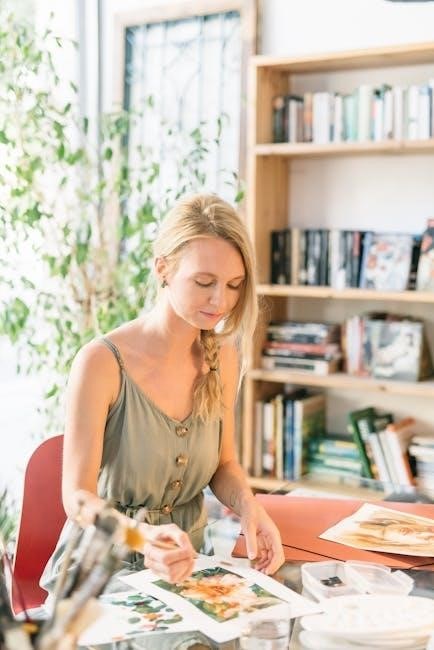Watercolor tutorial books offer comprehensive guides for mastering watercolor techniques, covering topics like color mixing, washes, and step-by-step projects. They cater to all skill levels, providing inspiration and practical advice.
What is a Watercolor Tutorial Book?
A watercolor tutorial book is a structured guide designed to teach artists the fundamentals and advanced techniques of watercolor painting. These books typically include step-by-step lessons, exercises, and projects to help learners master various aspects of the medium. They often feature detailed instructions, illustrations, and examples to demonstrate methods such as color mixing, brushwork, and composition. Many tutorial books cater to specific interests, such as painting florals, landscapes, or wildlife, while others focus on broader topics like color theory and experimental techniques. Whether for beginners or experienced artists, these books provide inspiration, practical advice, and a clear pathway to improving watercolor skills. They are invaluable resources for anyone looking to explore the versatility and beauty of watercolor painting.
The Evolution of Watercolor Painting
Watercolor painting has a rich history, evolving from ancient civilizations to modern times. Early use of water-based pigments dates back to cave paintings and Egyptian art. In the Middle Ages, watercolor was primarily used for manuscript illumination. The Renaissance period saw its application in botanical illustrations, while the 18th and 19th centuries brought it to prominence with artists like J.M.W. Turner, who emphasized light and atmosphere. Today, watercolor is a versatile medium used for landscapes, portraits, and abstract works. Tutorial books now play a key role in preserving and advancing these techniques, offering insights into both traditional methods and contemporary innovations. This evolution reflects the medium’s adaptability and enduring appeal, making it a timeless art form for learners and professionals alike;
Why Watercolor Tutorial Books are Essential for Beginners
Watercolor tutorial books are indispensable for beginners, offering structured guidance to navigate the medium’s unique challenges. These books provide step-by-step instructions, breaking down complex techniques into manageable exercises. They often include practical lessons on color theory, wash methods, and brush control, helping novices build a strong foundation. Many tutorial books feature inspirational projects that encourage creativity while teaching essential skills. Additionally, they address common pitfalls, such as managing water-to-pigment ratios and correcting mistakes. With detailed illustrations and clear instructions, these resources demystify watercolor painting, making it accessible to those new to the art form. Whether focusing on landscapes, florals, or wildlife, tutorial books serve as a comprehensive guide, helping beginners overcome initial hurdles and grow confident in their abilities.
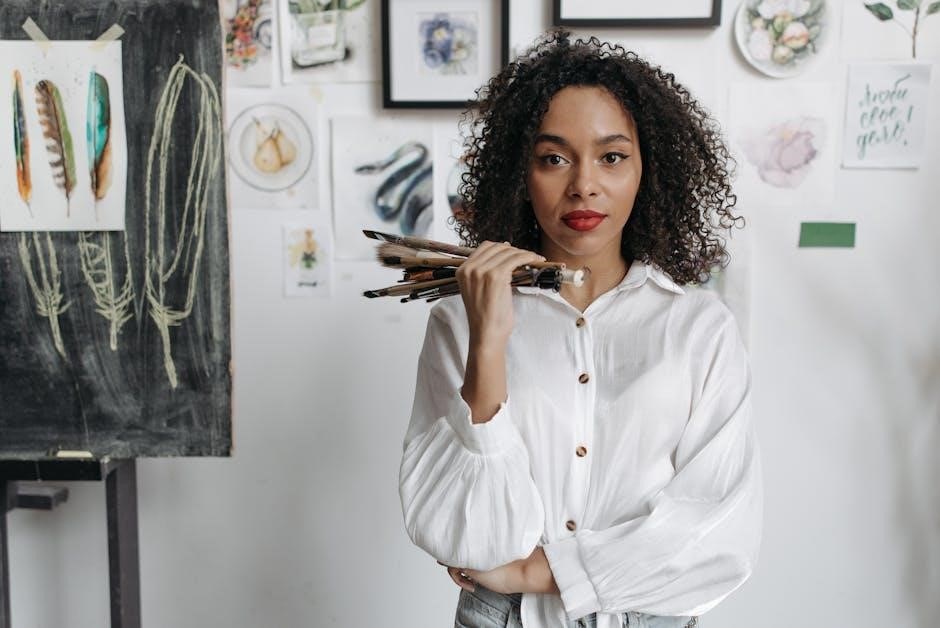
Materials and Supplies for Watercolor Painting
Essential supplies include high-quality watercolor paints, a variety of natural and synthetic brushes, heavyweight watercolor paper, and tools like palettes, water containers, and masking fluid for precise control and creativity.
Essential Watercolor Painting Supplies
Starting with watercolor painting requires a few key supplies to ensure success. Watercolor paints come in pans or tubes and vary in quality and lightfastness. Choose high-quality brushes made from natural or synthetic fibers, as they hold water and pigment better. Watercolor paper is a cornerstone, with weights like 140lb or 300gsm being ideal for beginners. A palette or mixing surface is necessary for blending colors, and a water container is essential for rinsing and mixing. Additional tools like masking fluid, a pencil, and a sharpener can enhance your creativity. Optional items include spray bottles for wetting paper and tissues for blotting. Investing in these basics ensures a solid foundation for learning and experimenting with watercolor techniques, as outlined in tutorial books like Everyday Watercolor Seashores and Creative Watercolor: A Step-By-Step Guide for Beginners.
Understanding Watercolor Paper Quality
Watercolor paper quality is crucial for achieving desired results in painting. Papers vary in weight, texture, and material, with 140lb (300gsm) being a popular choice for beginners. Hot press papers are smooth for fine details, while cold press and rough textures offer unique effects. Look for 100% cotton papers, as they are durable and resistant to distortion. Acid-free and lignin-free options ensure longevity. The paper’s size and surface preparation also matter, with pre-stretched or watercolor blocks saving time. Investing in high-quality paper enhances your learning experience and the overall outcome of your work, as emphasized in books like Everyday Watercolor Seashores and Creative Watercolor: A Step-By-Step Guide for Beginners.
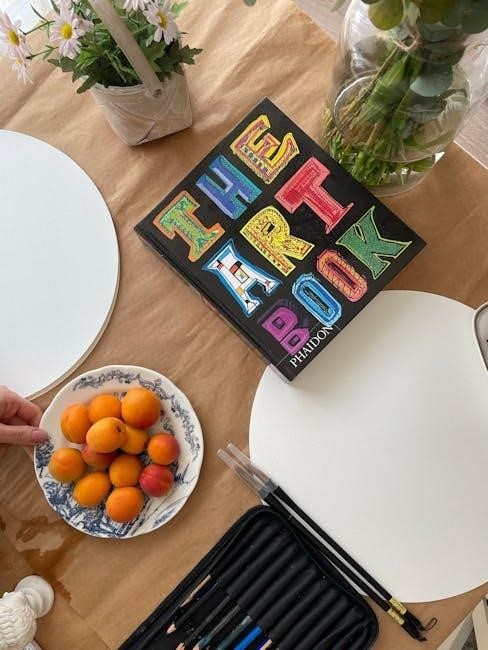
Choosing the Right Watercolor Brushes
Selecting the right watercolor brushes is essential for achieving precise strokes and desired effects. Brushes come in various shapes, sizes, and materials, with natural hair like sable or synthetic fibers being popular choices. Round brushes are ideal for detail work, while flat brushes are great for broad washes. A 1-inch flat brush is versatile for covering large areas, and a #6 round brush is perfect for fine details. Synthetic brushes are durable and affordable, while natural hair brushes hold more water for smoother blending. Brands like Winsor & Newton offer high-quality options. Additionally, mop brushes are excellent for soft, blended backgrounds. Investing in a variety of brushes allows you to explore different techniques. Proper care, like cleaning and storing brushes flat, ensures longevity. Books like Everyday Watercolor Seashores and Creative Watercolor: A Step-By-Step Guide for Beginners often provide insights into brush selection and maintenance.
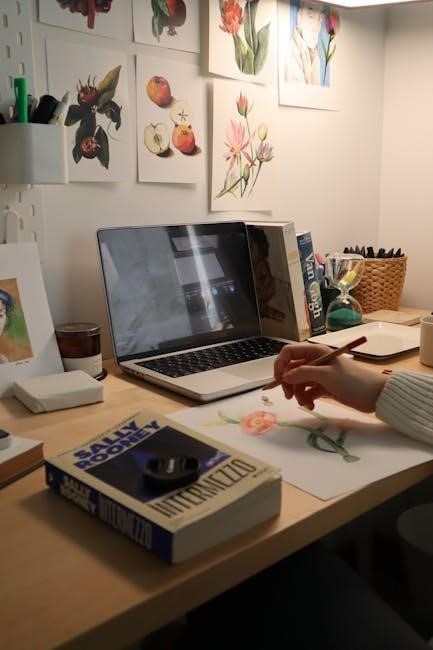
Basic Techniques in Watercolor Painting
Mastering washes, layering, and blending is fundamental. These techniques create depth, texture, and luminosity. Tutorial books guide learners through exercises to refine strokes and achieve desired effects in watercolor art.
Color Theory Basics for Watercolor
Color theory is fundamental to watercolor painting, helping artists understand how to mix and apply pigments effectively. It explores primary and secondary colors, warm and cool tones, and how they interact. Tutorial books often include practical exercises to demonstrate color mixing, such as creating washes and gradients. Learning about color harmony and contrast is essential for achieving balanced compositions. Books also cover the importance of the color wheel in planning palettes and understanding pigment properties. These lessons help beginners create vibrant, cohesive works while mastering the translucent nature of watercolor. By grasping color theory basics, artists can confidently experiment with hues, ensuring their paintings evoke the desired mood and depth. Tutorial guides provide step-by-step examples, making complex concepts accessible and fun to explore.
Mastering Wash Techniques
Mastering wash techniques is a cornerstone of watercolor painting, enabling artists to create smooth, even layers of color. Tutorial books often dedicate sections to teaching various wash methods, such as flat washes for uniform backgrounds or gradient washes for subtle transitions. These techniques are essential for achieving soft, blended effects and setting the foundation for detailed work. Books provide step-by-step guidance on preparing the right water-to-pigment ratio and using the appropriate brushstrokes. Practicing washes helps artists control the fluidity of watercolor and understand how pigments interact with paper. Many tutorials emphasize the importance of allowing washes to dry completely before adding subsequent layers. By mastering these fundamentals, artists can achieve the delicate, translucent quality that watercolor is known for, enhancing their ability to create striking, professional-level paintings.
Layering and Blending in Watercolor
Layering and blending are essential techniques in watercolor painting, allowing artists to achieve depth, luminosity, and intricate details. Tutorial books often devote sections to these methods, explaining how to build up colors gradually and merge them seamlessly. Layering involves applying multiple thin washes to create rich, vibrant hues, while blending focuses on softening edges and merging colors wet-on-wet. These techniques are crucial for capturing subtle shifts in light and shadow. Books provide practical exercises, such as glazing and wet-on-dry approaches, to help artists master these skills. Tips on allowing layers to dry completely and using the right brushstrokes are emphasized to avoid muddying colors. By practicing layering and blending, artists can unlock the full expressive potential of watercolor, creating works that are both delicate and dynamic.
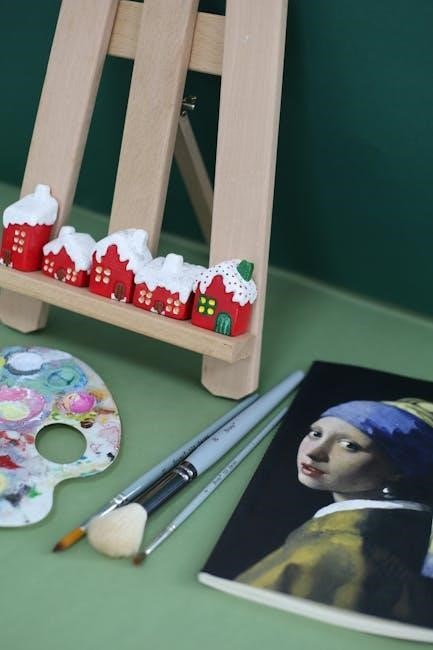
Step-by-Step Watercolor Projects
Watercolor tutorial books feature detailed, step-by-step guides for painting florals, landscapes, and wildlife. These projects help learners progress from simple exercises to complex compositions, enhancing their skills and creativity.
Simple Watercolor Exercises for Beginners
Simple watercolor exercises are designed to help beginners build foundational skills. These include basic wash techniques, color mixing, and painting simple shapes like flowers or leaves. Tutorial books often start with these exercises to ensure learners understand the basics before moving on to more complex projects. By practicing these exercises, beginners can familiarize themselves with watercolor behavior, pigment transparency, and brush control. Many tutorial books, such as those by Sarah Simon or Ana Victoria Calderón, offer step-by-step guidance for these exercises. They also provide tips on overcoming common challenges, like managing water flow or achieving desired hues. These exercises are essential for building confidence and preparing for more intricate watercolor projects, such as landscapes or wildlife painting.
Painting Florals with Watercolor
Painting florals with watercolor is a popular subject for artists, offering a creative way to practice techniques like layering, blending, and color mixing. Tutorial books often include step-by-step exercises for painting flowers, from simple blossoms to intricate botanicals. These exercises help learners master the delicate, translucent qualities of watercolor. Many books, such as “Everyday Watercolor Seashores” and “Modern Watercolor Botanicals,” provide detailed guidance on capturing the softness of petals and the vibrancy of floral colors. Techniques like wet-on-wet and glazing are frequently highlighted to achieve lifelike results. Additionally, these guides often emphasize the importance of observation and simplifying complex floral forms. By following these tutorials, artists can develop the skills to create stunning floral compositions, whether for standalone pieces or as part of larger landscapes.
Creating Landscapes in Watercolor
Creating landscapes in watercolor is a rewarding way to capture the beauty of natural scenes, from serene skies to intricate terrain. Tutorial books often provide detailed guidance on techniques like wet-on-wet, glazing, and negative painting to achieve soft, atmospheric effects. These guides emphasize the importance of planning and layering, helping artists build depth and perspective. Projects range from simple horizon lines to complex compositions with mountains, trees, and water reflections. Many books, such as “Everyday Watercolor Seashores” and “Modern Watercolor Botanicals,” include step-by-step exercises for painting landscapes. By following these tutorials, learners can master the challenges of capturing light, shadow, and texture in watercolor. These resources are invaluable for developing the skills needed to create vibrant, expressive landscape paintings that reflect the artist’s unique vision and connection to nature.
Painting Wildlife and Animals in Watercolor
Painting wildlife and animals in watercolor requires precision and creativity to capture their unique textures, expressions, and movements. Tutorial books dedicate sections to this niche, offering techniques for rendering fur, feathers, and eyes with lifelike detail. Many guides, such as those by contemporary artists, focus on loose, expressive styles to convey energy and emotion. Projects range from painting small creatures like birds and insects to larger subjects like bears and whales. These tutorials often include tips on layering, blending, and using glazes to achieve depth and luminosity. Books like “Atmospheric Animals in Watercolour” provide step-by-step instructions for mastering these challenging yet rewarding subjects. By following these guides, artists can learn to depict wildlife with both realism and artistic flair, making their work stand out in watercolor.
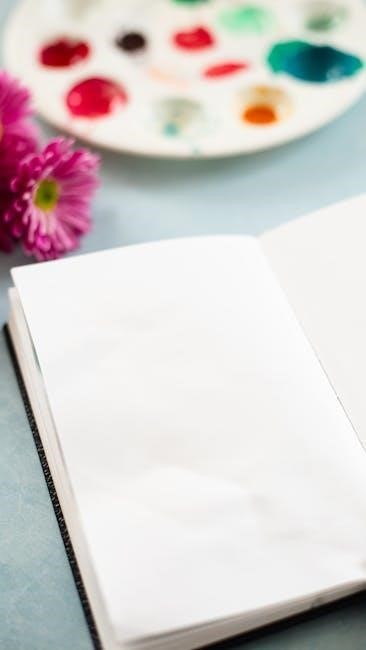
Inspiration and Motivation for Watercolor Artists
Watercolor tutorial books inspire artists by offering creative exercises, step-by-step guides, and beautiful examples to overcome challenges and stay motivated. They foster creativity and confidence in learners.
Overcoming Common Challenges in Watercolor
Watercolor tutorial books address common challenges like mastering washes, color control, and layering. They provide practical solutions and encouraging tips to help artists build confidence and improve their skills gradually.
Staying Motivated as a Watercolor Learner
Staying motivated while learning watercolor requires embracing challenges as opportunities for growth. Tutorial books provide step-by-step guides and inspiring projects to keep learners engaged. Setting small, achievable goals and celebrating progress helps build confidence. Many books include encouraging tips and warm-up exercises to make the process enjoyable. Learners are reminded that practice is key, and even simple exercises can lead to significant improvement. The iterative nature of watercolor, where mistakes can become unique elements, fosters creativity and persistence. Tutorial books also emphasize the joy of experimentation, encouraging artists to explore new techniques and styles. By focusing on the process rather than perfection, learners can stay motivated and continue their artistic journey with enthusiasm. Remember, every brushstroke brings you closer to mastering this beautiful medium.
How Tutorial Books Inspire Creativity
Watercolor tutorial books spark creativity by offering diverse projects and techniques that encourage artists to explore beyond their comfort zones. They often feature step-by-step guides that allow learners to experiment with new methods, such as layering, blending, and glazing. Many books include inspirational works from renowned artists, showcasing various styles and interpretations. These examples help learners visualize different approaches and adapt techniques to their own unique voice. Additionally, some tutorials incorporate mixed media elements, introducing paints, inks, and markers to expand creative possibilities. The combination of practical exercises and artistic inspiration fosters a sense of freedom and experimentation, enabling artists to develop their personal style. By providing a foundation of skills and endless ideas, tutorial books empower watercolor enthusiasts to unlock their full creative potential and bring their visions to life.
Advanced Watercolor Techniques
Advanced watercolor techniques, such as texture and effects, are explored in tutorial books, offering practical advice for creating unique, dynamic artworks with depth and luminosity.
Exploring Texture and Effects in Watercolor
Discover how to add texture and effects to your watercolor paintings through creative techniques such as salt sprinkling, scraping, and layering. These methods enhance visual interest and depth in your artwork. Tutorial books provide step-by-step guidance, helping you achieve dynamic, three-dimensional effects. From rough, organic textures to smooth, blended transitions, these techniques expand your artistic possibilities. Experiment with different tools like sponges, paper towels, and even household items to create unique effects. By mastering texture, you can add emotion and complexity to your work, making it stand out. Whether you’re painting landscapes, florals, or abstracts, incorporating texture and effects will elevate your watercolor skills to the next level. Explore these techniques in detailed tutorials and unlock new creative dimensions in your art.
Glazing Techniques for Depth and Luminosity
Glazing techniques in watercolor involve layering multiple thin, transparent washes to achieve deep, rich colors and a luminous effect. This method allows artists to build intricate, layered compositions by applying pigments gradually. By using highly transparent watercolor paints, you can create vibrant, jewel-toned hues that seem to glow. Glazing is particularly effective for capturing the subtleties of light and shadow, adding depth to your work. Tutorial books often provide detailed step-by-step instructions on how to master this technique, emphasizing the importance of allowing each layer to dry completely before adding the next. With practice, glazing can elevate your watercolor paintings, transforming them into captivating works of art. This technique is versatile and can be applied to various subjects, from still-life compositions to portraits and landscapes. Explore the magic of glazing and unlock new dimensions of color and light in your watercolor journey.
Mixed Media in Watercolor Painting
Mixed media in watercolor painting expands creative possibilities by combining traditional watercolor techniques with other materials. Artists often incorporate ink, markers, collage elements, and even textures like paper or fabric to add depth and visual interest. This approach allows for experimentation beyond conventional watercolor methods. Tutorial books frequently explore these techniques, offering step-by-step guidance on how to integrate diverse materials seamlessly. For instance, using markers for fine details or layering paint with ink can create dynamic, multi-dimensional effects. Mixed media also encourages artists to think outside the box, blending watercolor with digital tools or other artistic mediums. These innovative strategies not only enhance the creative process but also open up new avenues for expression. By embracing mixed media, watercolor artists can infuse their work with fresh perspectives and unique textures, making their paintings truly stand out.
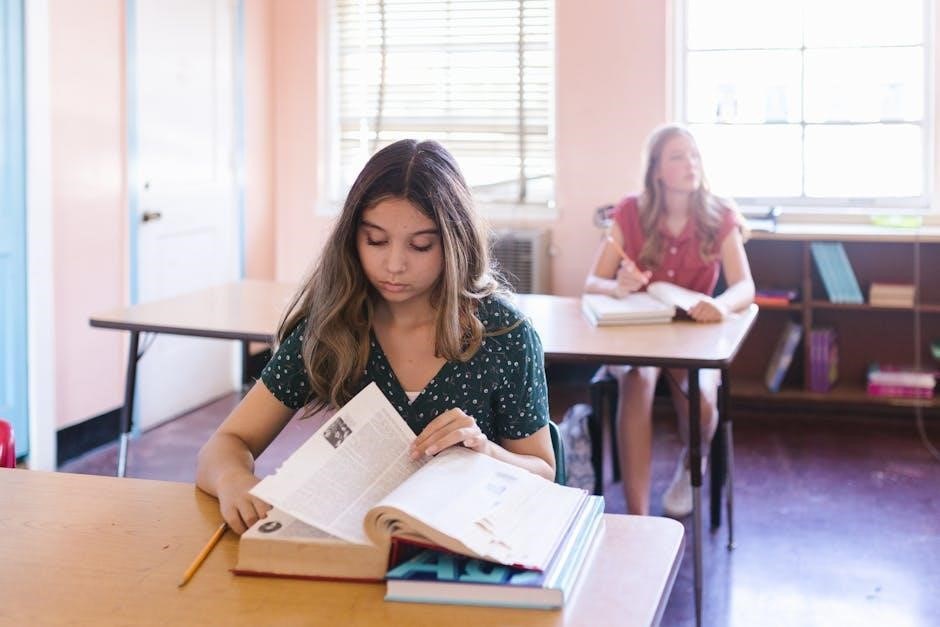
Prominent Watercolor Artists and Their Influence
Famous watercolor artists like Turner and contemporary painters inspire with their unique styles and techniques, influencing generations to explore and innovate in the medium.
Famous Watercolor Artists and Their Styles
Famous watercolor artists like J.M.W; Turner and Charles Rennie Mackintosh have left a lasting impact on the medium. Turner’s dramatic landscapes and mastery of light inspired generations, while Mackintosh’s delicate botanical watercolors showcased precision and elegance. Paul Klee, known for his experimental approaches, blended watercolor with other media, creating vibrant, expressive works. These artists’ unique styles and techniques are often featured in watercolor tutorial books, providing learners with inspiration and insights into diverse artistic approaches. By studying their methods, aspiring artists can gain a deeper understanding of color, composition, and creativity. Their contributions continue to influence contemporary watercolor practices, making their work a cornerstone of educational resources for both beginners and advanced painters.
Contemporary Watercolor Artists to Follow
Contemporary watercolor artists like Ana Victoria Calderón and Miranda Balogh are redefining the medium with fresh perspectives. Calderón’s vibrant, playful style often incorporates mixed media, while Balogh’s work focuses on botanicals and loose, expressive techniques. Their tutorials and books, such as Creative Watercolor and Modern Watercolor Botanicals, offer step-by-step guides and inspiration for learners. These artists share their processes online, making their work accessible to a global audience. By following their journeys, aspiring watercolorists can explore new trends, experiment with techniques, and stay motivated. Their influence extends beyond traditional art, blending watercolor with modern tools like markers and glitter, pushing the boundaries of what’s possible in the medium. Their contributions to tutorial books and online resources have made learning watercolor more engaging and approachable for artists of all levels.
